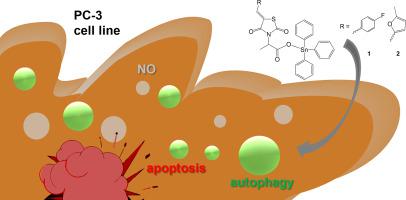Journal of Inorganic Biochemistry ( IF 3.8 ) Pub Date : 2020-07-26 , DOI: 10.1016/j.jinorgbio.2020.111207 Nebojša Đ Pantelić 1 , Bojana B Zmejkovski 2 , Bojan Božić 3 , Biljana Dojčinović 2 , Nebojša R Banjac 4 , Ludger A Wessjohann 5 , Goran N Kaluđerović 6

|
Two novel triphenyltin(IV) compounds, [Ph3SnL1] (L1 = 2-(5-(4-fluorobenzylidene)-2,4-dioxotetrahydrothiazole-3-yl)propanoate (1)) and [Ph3SnL2] (L2 = 2-(5-(5-methyl-2-furfurylidene)-2,4-dioxotetrahydrothiazole-3-yl)propanoate (2)) were synthesized and characterized by FT-IR, (1H and 13C) NMR spectroscopy, mass spectrometry, and elemental microanalysis. The in vitro anticancer activity of the synthesized organotin(IV) compounds was determined against four tumor cell lines: PC-3 (prostate), HT-29 (colon), MCF-7 (breast), and HepG2 (hepatic) using MTT (3-(4,5-dimethylthiazol-2-yl)-2,5-12 diphenyltetrazolium bromide) and CV (crystal violet) assays. The IC50 values are found to be in the range from 0.11 to 0.50 μM. Compound 1 exhibits the highest activity toward PC-3 cells (IC50 = 0.115 ± 0.009 μM; CV assay). The tin and platinum uptake in PC-3 cells showed a threefold lower uptake of tin in comparison to platinum (as cisplatin). Together with its higher activity this indicates a much higher cell inhibition potential of the tin compounds (calculated to ca. 50 to 100 times). Morphological analysis suggested that the compounds induce apoptosis in PC-3 cells, and flow cytometry analysis revealed that 1 and 2 induce autophagy as well as NO (nitric oxide) production.
中文翻译:

新型有机锡化合物与2-(5-亚芳基-2,4-二氧噻吩并恶唑烷-3-基)丙酸衍生物的合成,表征及体外生物学评价。
两种新型三苯基锡(IV)化合物[ Ph 3 SnL1](L1 = 2-(5-(4-氟亚苄基)-2,4-二氧四氢噻唑-3-基)丙酸酯(1))和[ Ph 3 SnL2](L2 = 合成2-(5-(5-(5-甲基-2-糠基亚基)-2,4-二氧四氢噻唑-3-基)丙酸酯(2)),并通过FT-IR,(1 H和13 C)NMR光谱表征,质谱和元素微量分析。在体外使用MTT测定了合成的有机锡(IV)化合物对四种肿瘤细胞系的抗癌活性:PC-3(前列腺),HT-29(结肠),MCF-7(乳腺癌)和HepG2(肝) 4,5-二甲基噻唑-2-基)-2,5-12溴化二苯基四唑)和CV(结晶紫)分析。发现IC 50值在0.11至0.50μM的范围内。化合物1对PC-3细胞表现出最高活性(IC 50 = 0.115±0.009μM; CV分析)。与铂(顺铂)相比,PC-3细胞中锡和铂的吸收显示锡吸收降低了三倍。连同其较高的活性,这表明锡化合物具有更高的细胞抑制潜能(计算为约50至100次)。形态分析表明该化合物诱导PC-3细胞凋亡,流式细胞仪分析表明1和2诱导自噬以及NO(一氧化氮)产生。











































 京公网安备 11010802027423号
京公网安备 11010802027423号